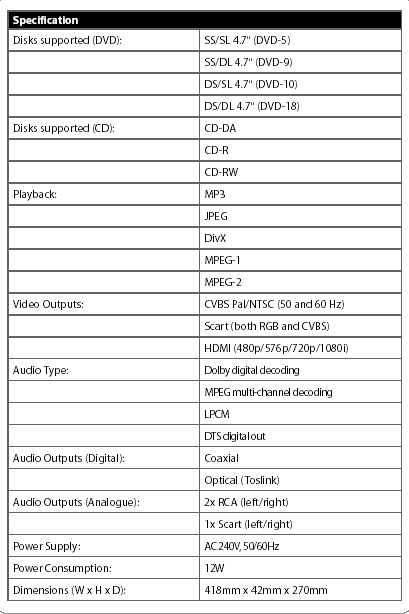Background and specifications
Background
Most current budget DVD players output a standard-definition signal to a display via an analogue SCART or S-Video connection. Better-featured models often carry an analogue component output that can transfer high-definition video.Standard-definition - meaning outputting to 480 and 576, either interlaced or the preferred progressive, and equating to the DVD format for the NTSC and PAL - is fine for traditional CRT televisions with limited resolution. However, the last 2-3 years have seen the burgeoning flat-panel market grow to the extent that most large-screen televisions currently sold are either LCD or plasma variants. Along with an all-digital connection, usually HDMI, they bring high-definition to the masses.
Complementing this high-definition revolution is the next-generation of digital storage media - Blu-ray and HD-DVD. Both formats will deliver video up to 1080p (1920x1080) resolution with higher-quality sound to match, and we've seen a steady number of titles trickle through in 2006, with the promise of hundreds more this year. Sony's Blu-ray-capable PlayStation 3 and recent price cuts to HD-DVD players are making them more attractive by the day.
Having a higher native resolution produces a better, clearer image: there's more data to display. Most current mid-sized flat-panel screens ship with 720p compatibility, that is, with the ability to display at least 720 vertical lines, yet their native resolution, however, tends to be 1366x768 pixels. A number of larger panels are now available with what's termed Full-HD support, which is represented by the panel's ability to display 1080 vertical lines, or 1080p - a la Blu-ray and HD-DVD.
With higher-resolution screens now pervasive and new formats that promise to leverage the best picture and sound quality possible, where does this leave your humble DVD collection? Remember, it's encoded at 720x576 (576p) and thus can't make best use of your high-def. display's abilities. A number of companies have pondered just this quandary and have released DVD players that plan to give your DVD collection a new lease of life by a method known as upscaling.
Upscaling
Upscaling, as the name suggests, takes the standard-definition DVD discs and outputs them to a higher resolution for better image quality. The question, really, is how can extra detail be added that isn't present on the disc? Upscaling players work by using a built-in video scaler that intelligently maps the output to the display, much in the same way as most decent TFTs scale between resolutions. Mapping to a high-def display's native resolution - or close to it - offers clearer images with more perceived detail.Upscaling players won't rival the output of true high-def. sources; the data simply isn't there, but they should offer a better-than SD viewing experience, or so the theory goes. Naturally, the better the video scaler and associated circuitry, the better the pseudo-HD picture.
Specifications
With that in mind, let's take a look at the Evesham DVD1000 specifications.

The DVD1000 outputs to high-def. displays via its HDMI connection. We appreciate that because HDMI is an all-digital connection, meaning that no extra digital-to-analogue and analogue-to-digital conversions need to take place before the images are sent to and received by the digital HD display. It also carries audio, too, but most users, we reckon, will opt to output sound separately, via the digital output, to a home-cinema amplifier.
The DVD1000 is also a multi-purpose player, supporting a wide variety of formats that include DivX and MP3 playback and JPEG image viewing. It's also region-free, but does not support WMA or MPEG-4 files, and by extention, XviD.
The specification is reasonable for a £70 player. Let's now see how it looks and, crucially, performs.









